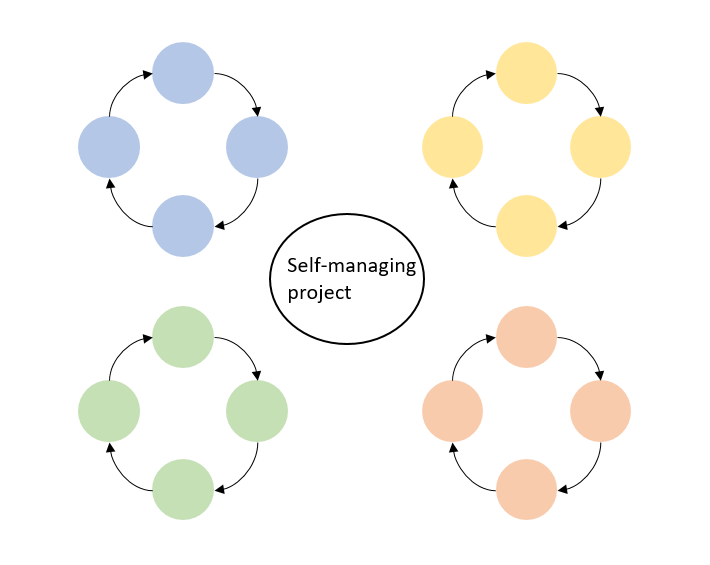9.4 Common Features in Organizations
Looking more broadly, organizations themselves can be seen as networks of teams. They can be formed through a formal or informal process. Formal teams facilitate formal learning where the goal of personal development is the most important aspect[10], much like project-based learning: the project should have importance, but not outweigh the learning objective. Informal teams facilitate informal learning. The organizational task is the most important part and the learning outcome is secondary[10]. Essentially, in an informal structure, the hope is that the learning is inherent, and that most people within the organizational group understand a solidified learning outcome when carrying out a project. An example of an informal structure would be surveying for a political candidate. There is a script, and a general learned ability to engage members of the public, but that is secondary to completing the task of getting the questions answered by the citizens, and ensuring a vote for the candidate.
Establishing the type of organizational team identity can explore different types of teamwork styles within learning organizations. Some of the more recent teamwork trends follows three models:
- cross-functional teams
- virtual teams
- self-managing teams
Given that learners come from different disciplines, especially in a learning organization, such as a university, it would not be out of the scope for learners to come together from different disciplines. Cross-functional teams are members within different groups who work together on a project. This teamwork trend follows an interdisciplinary nature that involves new ideas through cross-departmental cooperation. An example of this, in a university setting, would be the faculty of education working with the faculty of psychology to introduce a minor degree in educational psychology of elementary-school students. This brings educational expertise and psychology expertise together, merging the disciplines to create a beneficial topic for the greater good of society.

In the same thread as cross-functional teams are virtual teams, which can be cross-functional but are computer-orientated, rather than face-to-face interactions. One positive advantage is that effective work can be done with people outside of the geographic area. A disadvantage of virtual teams is the lack of face-to-face interaction which limits the roles of emotions during the communication process. Using the previous example, the group who has worked together on an educational-psychology minor at a school in Toronto can coordinate with a school in Vancouver virtually, and in real-time, discussing the prospects of the degree.

What about teams without a clear central figure at the helm? Self-managing teams are autonomous for the individuals of the group, and they are given authority about how they go about their tasks. Self-managing teams must have members who are competent working together and embrace participative decision-making, delivering better performance, decreased cost, and higher morale. In the previous sample, this would mean letting the education department and the psychology department work on the components of this minor without the central figure of the university administration managing the process. In this way, university administration allows the experts to manage their respective teams, and be available for problem-solving with events that extend beyond the scope of both departments.

Characteristics of High Performing Teams
Regardless of the teamwork methods, all members of the team have to be high performing. According to Schein, there are seven characteristics that high performing teams have[11]:
- Clear and elevating goals
- Task-driven, results-oriented
- Competent, hard-working members
- Collaborative culture
- High standards of excellence
- External support and recognition
- Strong principled leadership
High performing teams use a contingency model through a valid model of experiential learning[12]. Through experience comes a sense contingency with building skills, and with high performing teams the seven factors help produce the building of collaborative and organizational skills.
Review Questions:
- What are the differences between formal and informal teams?
- What are the differences between cross-functional, virtual and self-managing projects?
- What are seven characteristics of high preforming teams?
Facilitate formal learning which the goal of personal development is the most important aspect
Facilitate informal learning, the organizational task is the most important and the learning outcome is secondary
Members within different groups who work together on a project
Described as cross-functional but are computer-orientated, rather than face-to-face interactions
Sets of teams with autonomy, and they are given authority as to how they go about their tasks

